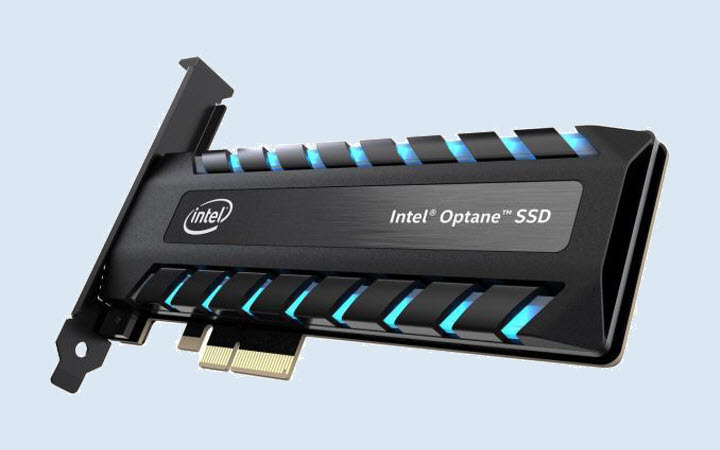Intel Optane AMA Reader's Recap, Storage, Caching and Memory Explained
Optane for Gaming, Latency Performance, and the Future of Optane
Q: We've seen quite a few questions here at Tom's regarding pairing a 16GB or 32GB Optane module with a traditional SSD. Given that current SSDs are "fast," especially regarding the near-zero access times, even SATA III but especially NVMe, is there a real point or benefit for a typical consumer system to merge these two technologies? I can absolutely see it paired with an old-school spinning platter, but on top of an already fast SSD?
For instance - my house systems are all SSD only. Currently top-grade SATA III, but the next iteration will be NVMe drives. The 905p is too expensive per GB, but would I benefit from a 32GB Optane paired with an NVMe and sufficient system DRAM, or are we chasing ever decreasing benefits?
A: No, we're not chasing ever-decreasing benefits--and yes, we do see the benefit of a combined solution. Check this out! Stay tuned for more details later.
Q: I have a huge amount of games (700+) that I would like to have installed in my next build. Because of this very large amount of data I will require lots of storage space, and would like to use something like the Seagate BarraCuda Pro ST14000DM001 14TB 7200 RPM 256MB Cache SATA 6.0Gb/s 3.5" Internal Hard Drive with an Optane drive to increase speed. Is the best option to use the Optane Memory M10 Series (64GB, M.2 80mm PCIe 3.0, 20Nm, 3D XPoint) or to go with something bigger, say the Intel Optane SSD 905P Series M.2 22110 380GB PCI-Express 3.0 x4 3D XPoint Internal Solid State Drive?
A: For your best performance, you want the operating system and the application running on your fastest media--which, in this case, should be an Intel Optane SSD. In my case it's Windows and World of Tanks, but you seem to have a few more games than I do!
Q: Optane does not need the UNMAP command. Does that mean there is no internal garbage collection? If I continuously rewrite to an Optane drive, can I expect any performance degradation? Does the concept of write amplification apply on Optane? If so, under what circumstances?
A: To answer your first two questions: Intel Optane is a write-in-place media, therefore it incurs no performance penalties from garbage collection or its associated write amplification. We have defenestrated garbage collection!
Get Tom's Hardware's best news and in-depth reviews, straight to your inbox.
Q: What user space library would you suggest to obtain the highest IOPs with small block sizes (ie. 4KB blocks)? Are you using SPDK or a different toolkit when testing Optane drives?
A: We use SPDK (check out this link). It's well named as a Storage Performance Development Kit.
Q: Do you know if CPU core frequency has a significant impact on Optane latency?
A: These are independent, but Intel Optane's ability to deliver data quickly means that your CPU's utilization increases dramatically. As an example, check this out from the Evaluator Group.
Q: In the specifications we can find write and read and latency are both 10µs. Fast hardware is putting more and more pressure on the software stack. Is the current generation of Optane drives already slowed down by the software stack (drivers, user space library)?
A: Software can't hide behind slow storage anymore! There's a lot of work going on between Intel and the software community, (ISV and Open Source), to continuously optimize applications to take advantage of Intel Optane's amazing performance.
Q: Is there any access pattern which can lead to better latencies (sequential vs random, strided vs non-stride, offset, or something else)?
A: Intel Optane's ability to operate at tight peak performance at low queue depths--combined with high-balanced read/write performance--enables it to deliver amazing performance with any access pattern. So, not only is it fast--it's always fast.
Q: In what time frame do you think the 3D XPoint technology could reach latencies below the microsecond?
A: We're about to launch it on the memory channel where the latency is measured in nanoseconds. So, now!
Q: Is there any chance to see some hybrid drives (3D XPoint + NAND)? If so, do you think users/the OS will be able to select in which region to write? I believe that feature would be really interesting for new kind of file systems (for instance to put metadata and small data fragments on 3D XPoint).
A: It's even better than a chance! At CES, we disclosed Intel Optane Memory H10 with Solid State Storage. It combines the responsiveness of Intel Optane memory and the storage capacity of QLC NAND in a single M.2 form factor. More details coming soon.
Image Credits: Intel
Current page: Optane for Gaming, Latency Performance, and the Future of Optane
Prev Page Optane for Servers, Older PCs, and the MainstreamJoshua Simenhoff was a former Tom's Hardware community manager. He covered a wide range of topics, including PC hardware how-tos and articles with a focus on community engagement. His expertise lay in connecting with readers and providing practical, informative content about the latest technology.

